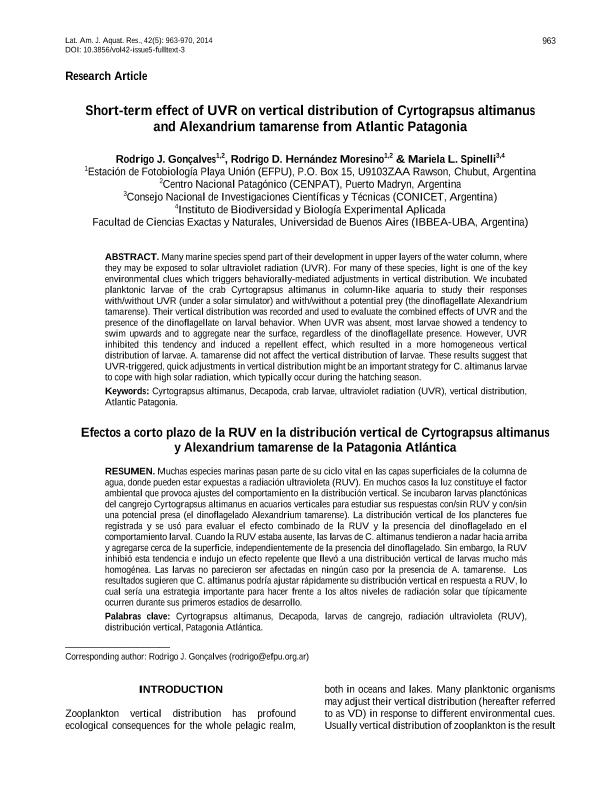Mostrar el registro sencillo del ítem
dc.contributor.author
Gonçalves, Rodrigo Javier

dc.contributor.author
Hernández Moresino, Rodrigo Daniel

dc.contributor.author
Spinelli, Mariela Lorena

dc.date.available
2016-12-07T15:09:21Z
dc.date.issued
2014-11
dc.identifier.citation
Gonçalves, Rodrigo Javier; Hernández Moresino, Rodrigo Daniel; Spinelli, Mariela Lorena; Short-term effect of UVR on vertical distribution of Cyrtograpsus altimanus and Alexandrium tamarense from Atlantic Patagonia; Pontificia Universidad Catolica de Valparaíso; Latin American Journal Of Aquatic Research; 42; 5; 11-2014; 963-970
dc.identifier.issn
0718-560X
dc.identifier.uri
http://hdl.handle.net/11336/8964
dc.description.abstract
Many marine species spend part of their development in upper layers of the water column, where they may be exposed to solar ultraviolet radiation (UVR). For many of these species, light is one of the key environmental clues which triggers behaviorally-mediated adjustments in vertical distribution. We incubated planktonic larvae of the crab Cyrtograpsus altimanus in column-like aquaria to study their responses with/without UVR (under a solar simulator) and with/without a potential prey (the dinoflagellate Alexandrium tamarense). Their vertical distribution was recorded and used to evaluate the combined effects of UVR and the presence of the dinoflagellate on larval behavior. When UVR was absent, most larvae showed a tendency to swim upwards and to aggregate near the surface, regardless of the dinoflagellate presence. However, UVR inhibited this tendency and induced a repellent effect, which resulted in a more homogeneous vertical distribution of larvae. A. tamarense did not affect the vertical distribution of larvae. These results suggest that UVR-triggered, quick adjustments in vertical distribution might be an important strategy for C. altimanus larvae to cope with high solar radiation, which typically occur during the hatching season.
dc.description.abstract
Muchas especies marinas pasan parte de su ciclo vital en las capas superficiales de la columna de agua, donde pueden estar expuestas a radiación ultravioleta (RUV). En muchos casos la luz constituye el factor ambiental que provoca ajustes del comportamiento en la distribución vertical. Se incubaron larvas planctónicas del cangrejo Cyrtograpsus altimanus en acuarios verticales para estudiar sus respuestas con/sin RUV y con/sin una potencial presa (el dinoflagelado Alexandrium tamarense). La distribución vertical de los plancteres fue registrada y se usó para evaluar el efecto combinado de la RUV y la presencia del dinoflagelado en el comportamiento larval. Cuando la RUV estaba ausente, las larvas de C. altimanus tendieron a nadar hacia arriba y agregarse cerca de la superficie, independientemente de la presencia del dinoflagelado. Sin embargo, la RUV inhibió esta tendencia e indujo un efecto repelente que llevó a una distribución vertical de larvas mucho más homogénea. Las larvas no parecieron ser afectadas en ningún caso por la presencia de A. tamarense. Los resultados sugieren que C. altimanus podría ajustar rápidamente su distribución vertical en respuesta a RUV, lo cual sería una estrategia importante para hacer frente a los altos niveles de radiación solar que típicamente ocurren durante sus primeros estadios de desarrollo.
dc.format
application/pdf
dc.language.iso
eng
dc.publisher
Pontificia Universidad Catolica de Valparaíso

dc.rights
info:eu-repo/semantics/openAccess
dc.rights.uri
https://creativecommons.org/licenses/by-nc-nd/2.5/ar/
dc.subject
Crab Larvae
dc.subject
Vertical Distribution
dc.subject
Solar Ultraviolet Radiation
dc.subject
Zooplankton
dc.subject.classification
Biología Marina, Limnología

dc.subject.classification
Ciencias Biológicas

dc.subject.classification
CIENCIAS NATURALES Y EXACTAS

dc.title
Short-term effect of UVR on vertical distribution of Cyrtograpsus altimanus and Alexandrium tamarense from Atlantic Patagonia
dc.title
Efectos a corto plazo de la RUV en la distribución vertical de Cyrtograpsus altimanus y Alexandrium tamarense de la Patagonia Atlántica
dc.type
info:eu-repo/semantics/article
dc.type
info:ar-repo/semantics/artículo
dc.type
info:eu-repo/semantics/publishedVersion
dc.date.updated
2016-11-23T19:42:20Z
dc.journal.volume
42
dc.journal.number
5
dc.journal.pagination
963-970
dc.journal.pais
Chile

dc.journal.ciudad
Valparaíso
dc.description.fil
Fil: Gonçalves, Rodrigo Javier. Fundación Playa Unión. Estación de Fotobiología Playa Unión; Argentina. Consejo Nacional de Investigaciones Científicas y Técnicas. Centro Nacional Patagónico; Argentina
dc.description.fil
Fil: Hernández Moresino, Rodrigo Daniel. Fundación Playa Unión. Estación de Fotobiología Playa Unión; Argentina. Consejo Nacional de Investigaciones Científicas y Técnicas. Centro Nacional Patagónico; Argentina
dc.description.fil
Fil: Spinelli, Mariela Lorena. Consejo Nacional de Investigaciones Cientificas y Tecnicas. Oficina de Coordinacion Administrativa Ciudad Universitaria. Instituto de Biodiversidad y Biologia Experimental y Aplicada; Argentina
dc.journal.title
Latin American Journal Of Aquatic Research

dc.relation.alternativeid
info:eu-repo/semantics/altIdentifier/doi/http://dx.doi.org/10.3856/vol42-issue5-fulltext-3
dc.relation.alternativeid
info:eu-repo/semantics/altIdentifier/url/http://www.lajar.cl/resumen_en.php?cod=20141126132432&id=66
dc.relation.alternativeid
info:eu-repo/semantics/altIdentifier/url/http://ref.scielo.org/g5v9yr
Archivos asociados
